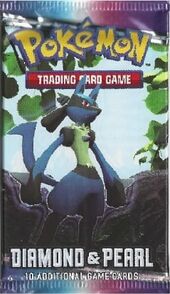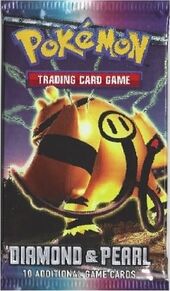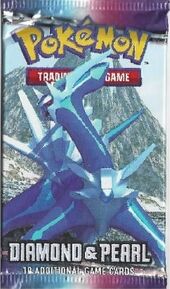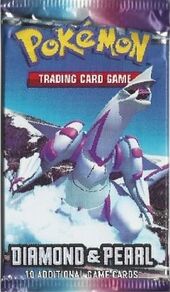Diamond & Pearl (TCG): Difference between revisions
Mattfeeder18 (talk | contribs) (Added Gallery with booster pack arts) |
Tags: Mobile edit Mobile web edit Advanced mobile edit |
||
| Line 42: | Line 42: | ||
A new numbering system for Pokémon was deployed on the lower left of the card, labelled '''DPBP#'''. This [[List of Pokémon by Diamond & Pearl Battle Pokédex number|Diamond & Pearl Battle Pokédex]] number system combined aspects of the [[List of Pokémon by National Pokédex number|National Pokédex]] and the [[List of Pokémon by habitat|habitat system]] featured in {{game|FireRed and LeafGreen|s}}. Japanese cards reverted to having no card numbering system. {{ct|Darkness}} and {{ct|Metal}} Pokémon were listed before {{ct|Colorless}} Pokémon. Evolutionary family were listed together. Attacks that required no Energy were introduced. | A new numbering system for Pokémon was deployed on the lower left of the card, labelled '''DPBP#'''. This [[List of Pokémon by Diamond & Pearl Battle Pokédex number|Diamond & Pearl Battle Pokédex]] number system combined aspects of the [[List of Pokémon by National Pokédex number|National Pokédex]] and the [[List of Pokémon by habitat|habitat system]] featured in {{game|FireRed and LeafGreen|s}}. Japanese cards reverted to having no card numbering system. {{ct|Darkness}} and {{ct|Metal}} Pokémon were listed before {{ct|Colorless}} Pokémon. Evolutionary family were listed together. Attacks that required no Energy were introduced. | ||
With the release of this expansion, numerous rule changes took place. Outside of Asia, Trainer, Supporter, and Stadium cards were considered separate types. The player going first could now draw a card at the beginning of their first turn, but couldn't play any of the aforementioned cards.<ref>[https://jklaczpokemon.com/dpp-decks/#rules The Epic Diamond & Pearl/Platinum Format: Decks & Tips § Rules – Retro Pokémon TCG]</ref> | |||
Each booster pack were increased from 9 cards to 10 cards; they include 5 Common, 3 Uncommon, 1 Reverse Holofoil, and 1 Rare or Rare Holo card. The Reverse Holofoil were no longer being Holofoil on the background of the artwork, instead it was Holofoil on the entire card excluding the artwork. Reverse Holofoil versions of the Rare Holo cards were also no longer being Holofoil on the artwork. | Each booster pack were increased from 9 cards to 10 cards; they include 5 Common, 3 Uncommon, 1 Reverse Holofoil, and 1 Rare or Rare Holo card. The Reverse Holofoil were no longer being Holofoil on the background of the artwork, instead it was Holofoil on the entire card excluding the artwork. Reverse Holofoil versions of the Rare Holo cards were also no longer being Holofoil on the artwork. | ||
Revision as of 00:25, 8 January 2024
- This article is about the Pokémon Trading Card Game expansion. For other uses, see Diamond and Pearl.
|
|
|
| |||||||||||||||||
| |||||||||||||||||
Pokémon TCG: Diamond & Pearl (Japanese: 時空の創造 Space-Time Creation: ダイヤモンドコレクション Diamond Collection and パールコレクション Pearl Collection) is the name given to the first main expansion of cards from the Diamond & Pearl Series of the Pokémon Trading Card Game (the DP Era in Japan). The set is the first to feature Generation IV Pokémon in the card game.
Blurb
New Pokémon, New Adventures!
The next generation of Pokémon has arrived! In Diamond & Pearl, you'll explore the never-before-seen Sinnoh region and catch brand-new Pokémon for the very first time. New gameplay, including the exciting Level Up that makes your Pokémon more powerful... new attacks... even a new look—the Pokémon TCG: Diamond & Pearl expansion will take every Trainer to the next level!
Information
Diamond & Pearl is the name given to the first main expansion of the Diamond & Pearl Series of the Pokémon Trading Card Game. In Japan, it was released as Diamond Collection and Pearl Collection, collectively known as Space-Time Creation, the first expansion in the Pokémon Card Game DP Era. It is based on Pokémon Diamond and Pearl, featuring Generation IV Pokémon and the two game Legendary Pokémon Dialga and Palkia. The English expansion was released on May 23, 2007, while the Japanese expansion was released on November 30, 2006.
Diamond & Pearl introduced Pokémon LV.X, a type of Pokémon. Pokémon LV.X are "Level-Up Pokémon" and is able to use any attack, Poké-Power, or Poké-Body from its previous Level. Poison-type Pokémon changed from being represented by the Grass-type to the Psychic-type. Supporter and Stadium cards were separate class of cards, rather than the subclass of Trainer cards. Both Darkness Energy and Metal Energy received new basic Energy forms which were free from the 4-per-deck rule. Cards that allow players to search for a Darkness or Metal Energy card may seek out either version. Unown were counted as separate Pokémon, with the letter after the name.
Diamond & Pearl also introduced an updated card design, which included numerous changes. The Pokémon's level returned and appeared on the right of the Pokémon's name. The word "HP" was smaller and appeared before the amount. The Evolution box moved to below the Pokémon's name. The Pokémon's Pokédex number, species, height, and weight were displayed below the artwork window. The circles on the left of the card no longer appeared. The Pokédex entry made its return and was located below the Pokémon Power and attack box. The illustrator's name was moved above the retreat cost.
A new numbering system for Pokémon was deployed on the lower left of the card, labelled DPBP#. This Diamond & Pearl Battle Pokédex number system combined aspects of the National Pokédex and the habitat system featured in Pokémon FireRed and LeafGreen. Japanese cards reverted to having no card numbering system. Darkness-type and Metal-type Pokémon were listed before Colorless-type Pokémon. Evolutionary family were listed together. Attacks that required no Energy were introduced.
With the release of this expansion, numerous rule changes took place. Outside of Asia, Trainer, Supporter, and Stadium cards were considered separate types. The player going first could now draw a card at the beginning of their first turn, but couldn't play any of the aforementioned cards.[1]
Each booster pack were increased from 9 cards to 10 cards; they include 5 Common, 3 Uncommon, 1 Reverse Holofoil, and 1 Rare or Rare Holo card. The Reverse Holofoil were no longer being Holofoil on the background of the artwork, instead it was Holofoil on the entire card excluding the artwork. Reverse Holofoil versions of the Rare Holo cards were also no longer being Holofoil on the artwork.
| ||||||||||||||||||||||||||||||||||||||||||||||||||||||||||||||||||||||||||||||||||||||||||||||||||||||||||||||||||||||||||||||||||||||||||||||||
| ||||||||||||||||||||||||||||||||||||||||||||||||||||||||||||||||||||||||||||||||||||||||||||||||||||||||||||||||||||||||||||||||||||||||||||||||
Set lists
Gallery
|
|
|
|
Languages this set is released in
The Space-Time Creation set (Diamond & Pearl Collection sets) were only released in Japanese, in both 1st and unlimited edition. The Diamond & Pearl set is released in English, German, French, Italian, Spanish, Portuguese, and Polish. Cards in the English, German, French, Italian, and Polish sets were also available as Reverse Holos. The Spanish and Portuguese versions of this set lacked any Reverse Holos.
In other languages
| ||||||||||||||||||||||||

|
This article is part of Project TCG, a Bulbapedia project that aims to report on every aspect of the Pokémon Trading Card Game. |
| Pokémon Trading Card Game expansions and releases Bold indicates a main expansion. Italics indicate a special set. Releases that are entirely composed of prints from other releases are small. | |||||
|---|---|---|---|---|---|
|
| ||||




